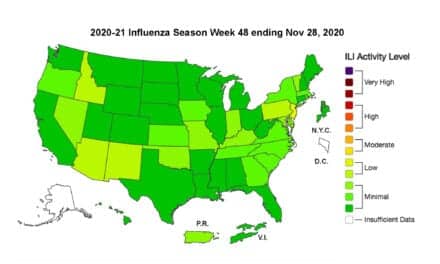Scientists presented new data about rates of co-infections with SARS-CoV-2, influenza, and respiratory syncytial virus (RSV) in the United States at the 2023 AACC Annual Scientific Meeting & Clinical Lab Expo, providing one of the first snapshots of the interplay among these common but potentially deadly viruses. Their work could lead to better diagnosis and patient management for all three illnesses, according to a release from AACC.
The research, which garnered results from more than 26,000 respiratory tests of US adults and children in late 2022, found co-infections in more than 1% of positive samples. Co-infections were especially widespread among those under the age of 21. The findings could have implications for how clinicians approach respiratory disease testing during future epidemics and seasonal outbreaks.
“With changing behaviors as the COVID pandemic began to recede, we felt it was important to investigate the resurgence of other respiratory viruses and potential incidents of co-infection, especially with the additional circulation of SARS-CoV-2,” says lead scientist George Pratt, PhD, at Quest Diagnostics, in a release.
Household respiratory viruses such as RSV pose major burdens on public health systems. Co-infections tend to occur when there are multiple outbreaks of respiratory diseases, such as in winter during flu season. Patients with multiple infections have a higher risk of severe disease and treatment complications, making it critical to understand how common co-infections are in the general population.
Co-infections can be especially problematic during an epidemic. For example, in late 2022, there was a spike in cases of RSV in the US, which coincided with the ongoing spread of COVID-19 and the appearance of seasonal influenza. But researchers have lacked the data to define rates of co-infections during this outbreak of RSV, which until recently had no vaccine.
Now, Pratt and colleagues present one of the first wide-ranging studies of co-infection rates in the US during the COVID-19 pandemic. In a retrospective study, they analyzed 26,657 respiratory tests from a clinical laboratory, gathered during a 107-day period in autumn of 2022. These tests included 9,800 samples from pediatric patients under the age of 21. The scientists tested the samples for RSV, SARS-CoV-2, and influenza A/B with the Roche cobas and Cepheid Xpert platforms.
“The most novel part of our research is the large sample size of results we had available as a part of co-testing in the Northeast,” says Pratt in a release. “Being able to look at over 26,000 test results was a great asset for our study.”
Overall, the tests revealed that co-infections with two or more of the viruses occurred in 1.33% of positive results and in .55% of the studied samples. The positivity rates varied by the viruses involved, ranging from .38% in adults for both SARS-CoV-2 and RSV to 2.28% in adults for both influenza A and SARS-CoV-2. However, co-infection rates in the pediatric group were higher than in the adult population for all three viruses.
Pratt notes that his team was surprised by the “very high” 6% co-infection rate of SARS-CoV-2 and influenza A in those under 21, which he says matched what was previously observed by the Centers for Disease Control and Prevention in hospitalized pediatric patients.
“As we experience more flu seasons and future epidemics of respiratory viruses, we’ll be able to acquire more co-infection rate data,” Pratt says in the release. “Our current work would make a useful data point to help evaluate whether future co-infection rates are shrinking or growing.”










